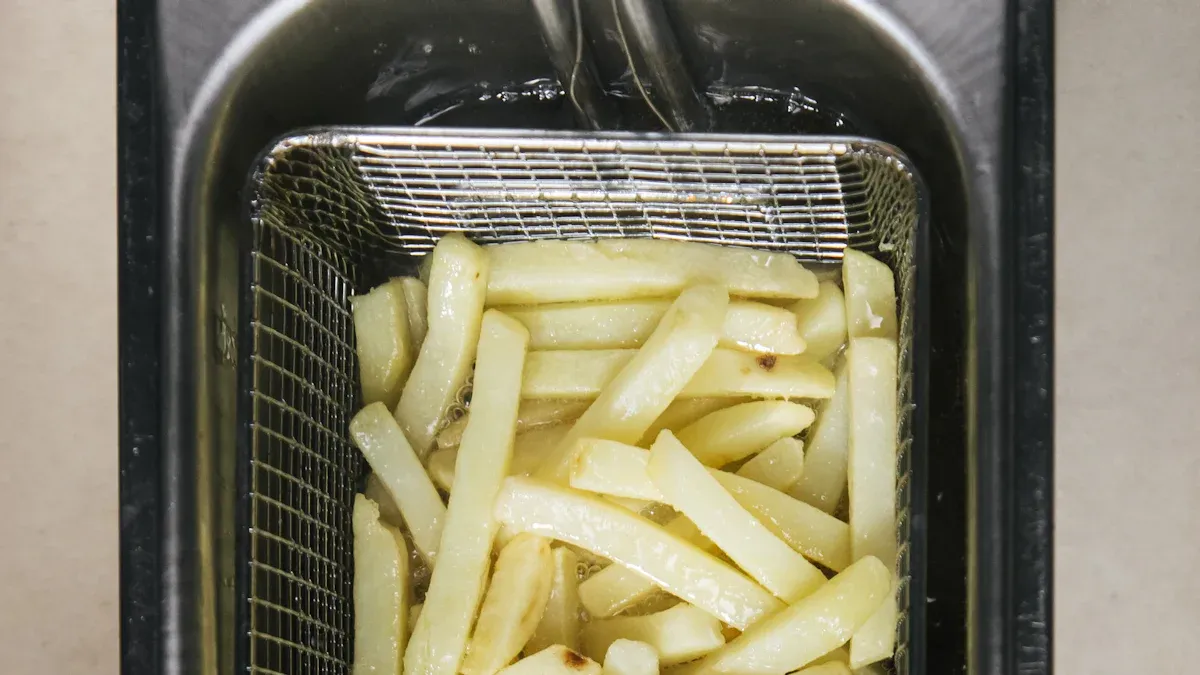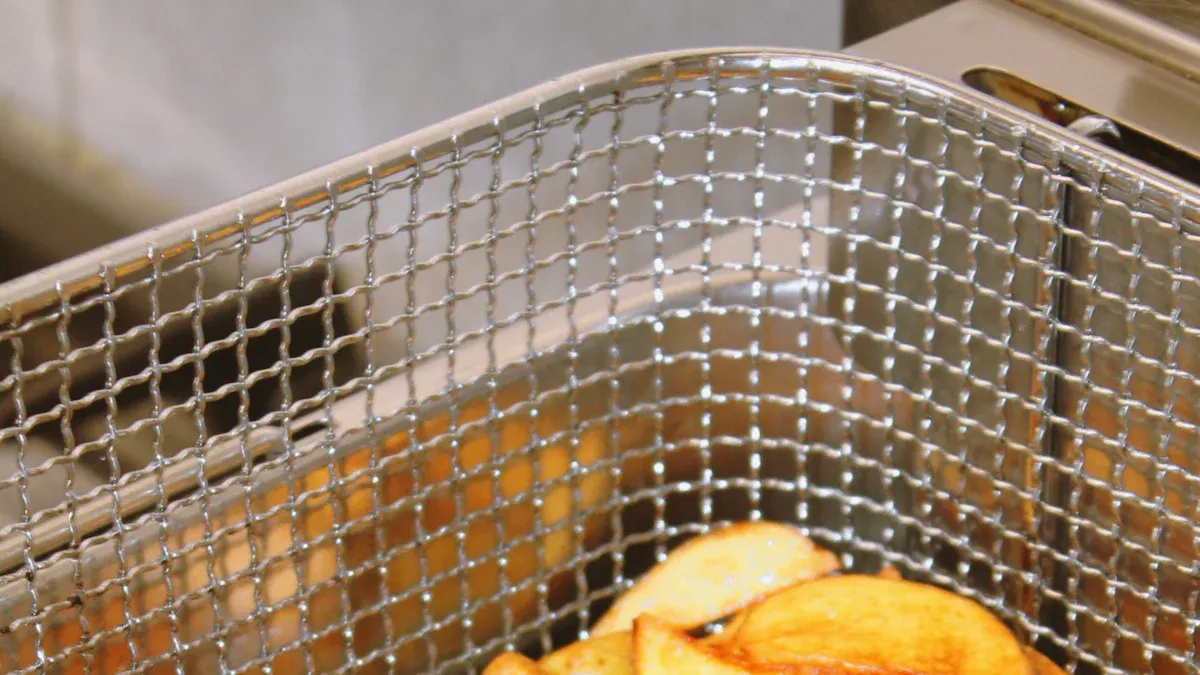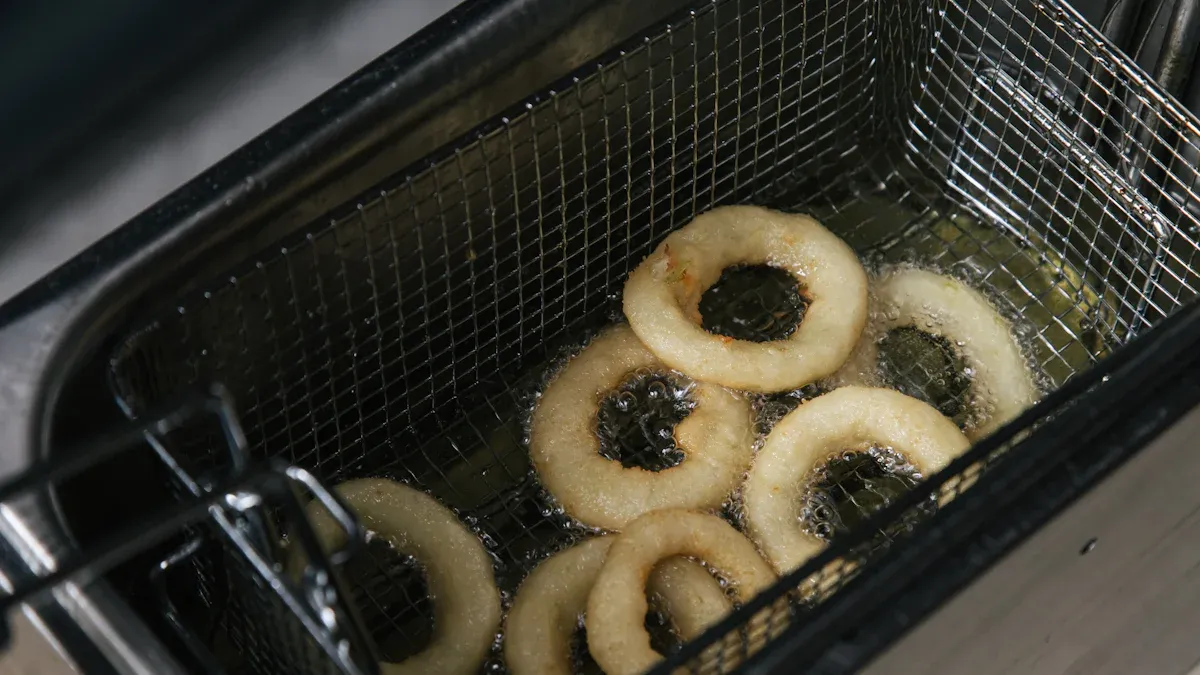
Air fryers have changed the way people cook at home. They use hot air to crisp food, cutting out the need for deep oil baths. Unlike electric deep fryers air fryer models, these devices require minimal oil, making meals lighter and healthier. Options like the LED digital control dual air fryer or the oil-free air fryer with dual basket create crispy dishes without guilt. For those seeking a deep oil free air fryer, it’s a game-changer for reducing calories and fat.
How Air Fryers Work

The Mechanism of Hot Air Circulation
Air fryers rely on a clever design that uses hot air to cook food. A heating element generates heat, while a powerful fan circulates this hot air around the food. This process creates a convection effect, ensuring even cooking and a crispy exterior. The rapid air movement mimics the results of deep frying but without the need for submerging food in oil.
Air fryers are engineered with precision. Their heating elements and fans undergo rigorous testing to ensure consistent heat distribution and energy efficiency. This attention to detail guarantees that food cooks evenly and retains its flavor.
Manufacturers continuously refine air fryer designs to meet consumer needs. Compact models with user-friendly controls make these appliances a practical choice for any kitchen.
Minimal Oil Usage for Cooking
One of the standout features of air fryers is their ability to cook with minimal oil. Unlike traditional frying methods, which require food to be submerged in oil, air fryers need only a small amount—sometimes just a spray or a teaspoon. This drastically reduces the calorie and fat content of meals.
For example, making French fries in an air fryer can cut down fat content by up to 75% compared to deep frying. This makes it easier to enjoy crispy, golden fries without the guilt. Plus, the reduced oil usage means less mess and easier cleanup.
Electric Deep Fryers Air Fryer: Key Differences in Cooking Methods
When comparing air fryers to electric deep fryers, the differences in cooking methods become clear. Air fryers use hot air circulation to cook food, while deep fryers rely on immersing food in hot oil. This fundamental difference impacts the texture, taste, and healthiness of the final dish.
- Air fryers excel at creating a crisp exterior, but deep fryers achieve a richer, more authentic fried consistency.
- Deep fryers can handle larger portions, whereas air fryers require smaller batches to ensure even cooking.
- Foods like chips from air fryers are healthier but may lack the uniform browning and crunchiness of those from deep fryers.
- Air fryers struggle with wet-battered foods, which deep fryers cook to perfection.
Despite these differences, air fryers remain a popular choice for those prioritizing health and convenience. They offer a way to enjoy fried-style foods with fewer calories and less fat, making them a valuable addition to modern kitchens.
Health Benefits of Air Fryers vs. Deep Fryers

Reduced Oil Consumption and Calorie Intake
Air fryers have revolutionized the way people enjoy fried foods by cutting down on oil usage. Unlike deep fryers, which require food to be submerged in oil, air fryers use hot air to achieve a crispy texture. This method drastically reduces calorie intake, making it easier to stick to dietary goals. For instance, French fries cooked in an air fryer can contain up to 75% less fat compared to their deep-fried counterparts.
Clinical studies also highlight the benefits of air frying. Research shows that air frying significantly reduces postprandial triglyceride levels, which are linked to heart health. Lower fat consumption aligns with dietary recommendations for managing fat intake and reducing the risk of coronary heart disease.
| Evidence Type | Findings |
|---|---|
| Clinical Study | Air frying significantly reduces postprandial triglyceride levels compared to deep frying. |
| Health Benefit | Linked to improved heart health and reduced risk of coronary heart disease. |
| Dietary Recommendation | Aligns with guidelines for lower fat consumption, aiding in fat intake management. |
Lower Fat Content in Air-Fried Foods
Air fryers excel at producing foods with lower fat content compared to deep fryers. This is especially important for individuals looking to manage their weight or improve their overall health. For example, air-fried cod contains only 1 gram of fat and 105 calories, while deep-fried cod has 10 grams of fat and 200 calories.
This difference makes air fryers a practical choice for those who want to enjoy fried-style foods without compromising their health. Whether it’s chicken wings, onion rings, or even desserts, air fryers deliver flavor and crunch with far fewer calories.
| Food Type | Calories | Fat (g) |
|---|---|---|
| Air-fried Cod | 105 | 1 |
| Deep-fried Cod | 200 | 10 |
Nutrient Retention and Reduced Harmful Compounds
Air fryers not only reduce fat but also help retain nutrients in food while minimizing harmful compounds. Studies show that air frying can decrease acrylamide formation by up to 90% in starchy foods, a compound linked to health risks. Additionally, air frying results in fewer polycyclic aromatic hydrocarbons (PAHs) and inflammatory compounds due to lower oil usage.
Here are some key findings:
- Air frying can reduce unhealthy fat consumption by up to 75%, leading to lower fat and calorie content.
- Acrylamide formation decreases by up to 90% in starchy foods compared to deep frying.
- Fewer PAHs and inflammatory compounds are produced due to reduced oil usage.
- Nutrient retention is supported, although more research is needed on the impact of air frying on vitamins and antioxidants.
This makes air fryers a safer and healthier option for cooking, especially for families looking to minimize exposure to harmful substances while preserving the nutritional value of their meals.
Addressing Common Misconceptions
Does Air-Fried Food Taste as Good as Deep-Fried Food?
Many people wonder if air-fried food can match the taste of deep-fried dishes. While deep fryers create a richer flavor due to the oil absorption, air fryers deliver a satisfying crunch with far less grease. The hot air circulation ensures even cooking, which enhances the natural flavors of the ingredients.
For foods like French fries or chicken wings, air fryers produce a crispy exterior that rivals traditional frying. Some users even prefer the lighter taste of air-fried dishes, as they don’t feel weighed down by excess oil. Adding seasonings or marinades can further boost the flavor, making air-fried meals just as enjoyable as their deep-fried counterparts.
Tip: Experimenting with spices and coatings can help achieve the desired taste and texture in air-fried foods.
Can Air Fryers Replicate the Texture of Deep-Fried Dishes?
Air fryers excel at creating crispy textures, but they don’t always replicate the exact crunch of deep-fried foods. Foods with wet batter, for instance, may not crisp up as well in an air fryer. However, for breaded items like chicken tenders or mozzarella sticks, the results are impressive.
The key lies in the cooking method. Air fryers use rapid hot air circulation to crisp food, while deep fryers rely on oil immersion. Although the textures differ slightly, air fryers still deliver satisfying crunchiness for most dishes.
Are Air Fryers Only for “Healthy” Foods?
Air fryers aren’t limited to health-conscious recipes. They’re versatile enough to prepare a wide range of dishes, from indulgent treats to everyday meals.
- The air fryer oven combination market is growing rapidly, driven by consumer demand for healthier and convenient cooking options.
- These appliances can bake, roast, and even grill, making them ideal for diverse cooking needs.
- Rising disposable incomes have made air fryer ovens popular for their multifunctionality, combining air frying with conventional oven features.
Whether it’s crispy fries, roasted vegetables, or baked desserts, air fryers cater to various tastes and preferences. They’re not just for dieters—they’re for anyone who loves quick, flavorful cooking.
Additional Benefits of Air Fryers
Versatility in Cooking Different Foods
Air fryers aren’t just for making fries or chicken wings. They can handle a wide range of dishes, from roasted vegetables to baked desserts. Some models even come with multiple cooking functions, like grilling, roasting, and dehydrating. This versatility makes them a great tool for experimenting with different recipes.
For example, an air fryer can roast a whole chicken, bake muffins, or even crisp up leftover pizza. It’s like having a mini oven that cooks faster and uses less energy. Whether someone wants to prepare a quick snack or a full meal, an air fryer can adapt to their needs.
Tip: Using accessories like baking pans or grill racks can expand the range of dishes an air fryer can make.
Ease of Cleaning and Maintenance
Cleaning up after cooking can be a hassle, but air fryers make it easier. Most models feature non-stick surfaces and dishwasher-safe components, which save time and effort. Unlike deep fryers, they don’t leave behind greasy oil residue that requires extensive scrubbing.
| Appliance | Ease of Cleaning |
|---|---|
| Air Fryer | Usually easier to clean due to non-stick surfaces and dishwasher-safe components. |
| Deep Fryer | Requires more effort to clean due to oil residue and may involve filtering and changing the oil. |
This ease of cleaning makes air fryers a practical choice for busy households. People can enjoy their meals without dreading the cleanup afterward.
Energy Efficiency Compared to Deep Fryers
Air fryers are also more energy-efficient than traditional deep fryers. They use less power while cooking food faster, which helps save on electricity bills.
| Appliance | Power Consumption |
|---|---|
| Air Fryers | 1.4 – 1.8 kWh |
| Deep Fryers | 1.0 – 3.0 kWh |
| Electric Oven | 2.0 – 5.0 kWh |
| Toaster Oven | 0.8 – 1.8 kWh |
Compared to electric ovens, air fryers consume significantly less energy. This makes them an eco-friendly option for those looking to reduce their carbon footprint. Plus, their shorter cooking times mean less energy is wasted, making them a win-win for both the environment and the wallet.
Fun Fact: Air fryers preheat in just a few minutes, unlike ovens that can take up to 15 minutes to reach the desired temperature.
Air fryers offer a healthier way to enjoy fried foods. They use less oil, cut calories, and keep nutrients intact. Plus, they’re versatile, easy to clean, and energy-efficient.
Looking for guilt-free crispy treats? An air fryer might be your perfect kitchen companion. It’s a smart choice for healthier cooking!
FAQ
1. Can you cook frozen foods in an air fryer?
Yes, air fryers handle frozen foods well. They cook evenly and quickly without needing to thaw, making them perfect for busy days.
2. Do air fryers make food healthier than baking?
Air fryers reduce oil usage compared to baking with added fats. They also retain nutrients better while delivering a crispy texture.
3. How long does it take to cook in an air fryer?
Cooking times vary by recipe, but most dishes take 10-20 minutes. Air fryers preheat quickly, saving time compared to traditional ovens.
Post time: May-19-2025

